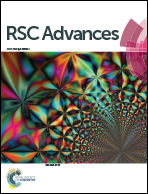A particle–carbon matrix architecture for long-term cycle stability of ZnFe2O4 anode†
Abstract
ZnFe2O4/C with a unique compound structure was in situ synthesized through a facile one-step route using glycine as complexing agent and carbon source. ZnFe2O4 nanoparticles are embedded in a carbon matrix to form submicron particles. The carbon matrix in the composite material is divided into surface carbon and inner carbon, not only facilitates the electronic conduction, but also inhibits the aggregation of ZnFe2O4 nanoparticles, which largely accommodates the mechanical stresses caused by the volume change of ZnFe2O4 during charge/discharge process. ZnFe2O4/C could maintain their integrity and provide excellent properties. The obtained ZnFe2O4/C has a specific capacity of 2055 mA h g−1 at 1000 mA g−1 and a capacity retention of 54% with the current density increasing from 100 to 5000 mA g−1. The excellent performance is derived from the unique compound structure and this facile fabrication method also has good prospects in synthesizing other materials.


 Please wait while we load your content...
Please wait while we load your content...